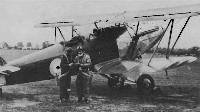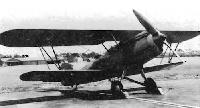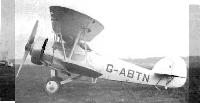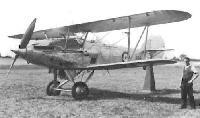Фотографии
-
Регистрационный номер: J9941 [2], G-ABMR [2], J9933 [2] Today preserved in the R.A.F. Museum at Hendon, Hawker Hart G-ABMR is shown here in the 1960s when it had been painted to represent an aircraft ol No. 57 Squadron and restored to flying condition
Самолёты на фотографии: Hawker Hart - Великобритания - 1928
-
Регистрационный номер: J9941 [2], G-ABMR [2], J9933 [2] Hart G-ABMR, Hawker's demonstrator, was restored to airworthy condition and painted in No. 57 Squadron colours after W.W.II. Since donated to the R.A.F. Museum, Hendon, where it now resides
Самолёты на фотографии: Hawker Hart - Великобритания - 1928
-
Регистрационный номер: K1430 First R.A.F. squadron to receive the Hart, in January 1930, was No. 33 at Eastchurch. K1430 in the foreground has a camera gun mounted on its lower port wing
Самолёты на фотографии: Hawker Hart - Великобритания - 1928
-
Регистрационный номер: K2088 A Hart (India), probably K2088, of No 39 Squadron, then based at Risalpur, flying over Gilgit on the North-West Frontier in October 1933
Самолёты на фотографии: Hawker Hart - Великобритания - 1928
-
Регистрационный номер: K2457 Another "atmospheric" formation shot of Harts, provided by No. 57 Squadron
Самолёты на фотографии: Hawker Hart - Великобритания - 1928
-
The first of four Pegasus-engined Harts built by Hawker's for the Swedish A.F. The type was later built under licence in Sweden, forty-two further aircraft being completed
Самолёты на фотографии: Hawker Hart - Великобритания - 1928
-
Регистрационный номер: K2978 Harts of No 601 (County of London) Squadron. Note 'Flying Sword" tin badge
Самолёты на фотографии: Hawker Hart - Великобритания - 1928
-
Регистрационный номер: J9052 [2] The Hart prototype, J9052, made its first flight in June 1928 at Brooklands; part of the embanked motor-racing track can be seen behind the tail.
Самолёты на фотографии: Hawker Hart - Великобритания - 1928
-
Регистрационный номер: J9052 [2] J9052 was later given folding wings to meet Naval Specification O.22/26
Самолёты на фотографии: Hawker Hart - Великобритания - 1928
-
Регистрационный номер: K3960 Harts of No. 15 Squadron rehearsing for the 1935 Hendon Air Pageant. K3960, (foreground), was one of a batch built by Armstrong-Whitworth
Самолёты на фотографии: Hawker Hart - Великобритания - 1928
-
Регистрационный номер: K4469, K4471, K4483 No 6 Squadron Hans K4483, '4471 and '4469 off the coast of Palestine
Самолёты на фотографии: Hawker Hart - Великобритания - 1928
-
Harts (India) serving with an F.T.S. at Ambala in 1941. Note yellow-ringed fuselage roundels
Самолёты на фотографии: Hawker Hart - Великобритания - 1928
-
Immaculate line-abreast vic formation flying by the pilots of No. 3 F.T.S. in their Hart (T) Series 2As; nearest aircraft are K5785, '5040, and ’5047
Самолёты на фотографии: Hawker Hart - Великобритания - 1928
-
Регистрационный номер: K1996 The prototype Hart Trainer, K1996, which first flow on 29th April 1932. It was actually the second production Audax modified
Самолёты на фотографии: Hawker Hart - Великобритания - 1928
-
Регистрационный номер: K5892 Yellow-painted Hart Trainer K5892 of No. 10 F.T.S. in 1939
Самолёты на фотографии: Hawker Hart - Великобритания - 1928
-
Регистрационный номер: K2434 Hart K2434 was used as a testbed for the Napier Dagger engine which was later to power the Hector
Самолёты на фотографии: Hawker Hart - Великобритания - 1928
-
Регистрационный номер: G-ABTN HAWKER PEGASUS HART. One of the radial-motor versions of the famous Hawker Hart family of the 1930s was the Pegasus Hart sometimes referred to as the "Swedish Hart" because it was licence-built in Sweden for Flygvapnet - the Royal Swedish Air Force.
G-ABTN (constructor's number H.H.3) was used both as a demonstrator and an engine test-bed. First with a Bristol Jupiter and later with the 625-h.p. Bristol Pegasus I.M.2 which gave a maximum speed of 177 m.p.h. and a service ceiling of 22,500 ft. for a loaded weight of 4,852 lb. (empty weight, 2,937 lb.). This photograph was taken at Brooklands in 1932. Later G-ABTN left Heston on 27th November 1932 for the Paris Aero Show. Returning three days later 'BTN met a watery end in the English Channel.Самолёты на фотографии: Hawker Hart - Великобритания - 1928
-
Hart pilot's cockpit
Самолёты на фотографии: Hawker Hart - Великобритания - 1928
-
Hawker Hart (Reproduced from original drawings issued by the Technical Library, Hawker Aircraft Ltd.)
Самолёты на фотографии: Hawker Hart - Великобритания - 1928
-
Produced for the S.A.A.F. the Hartbees was a close-support derivative with armour protection for the crew. "804" was one of four built by Hawker's and 65 more were completed in South Africa
Самолёты на фотографии: Hawker Hartbees - Великобритания - 1935
Статьи
- -
- C.Hobson - Avro York G-AHFA /Aeroplane Biography/
- E.Rees - D.H.71 Tiger Moth /Prototypes and Experimentals/
- G.Endres - Airlines of the World
- J.Holmes - The Hart Family (1)
- J.Stroud - Air Affairs
- M.Allward - Hawker Siddeley's AEW Nimrod /Design Profile/
- M.Taylor - Phantom Farewell
- N.MacKnight - F-105s over S.E. Asia



















